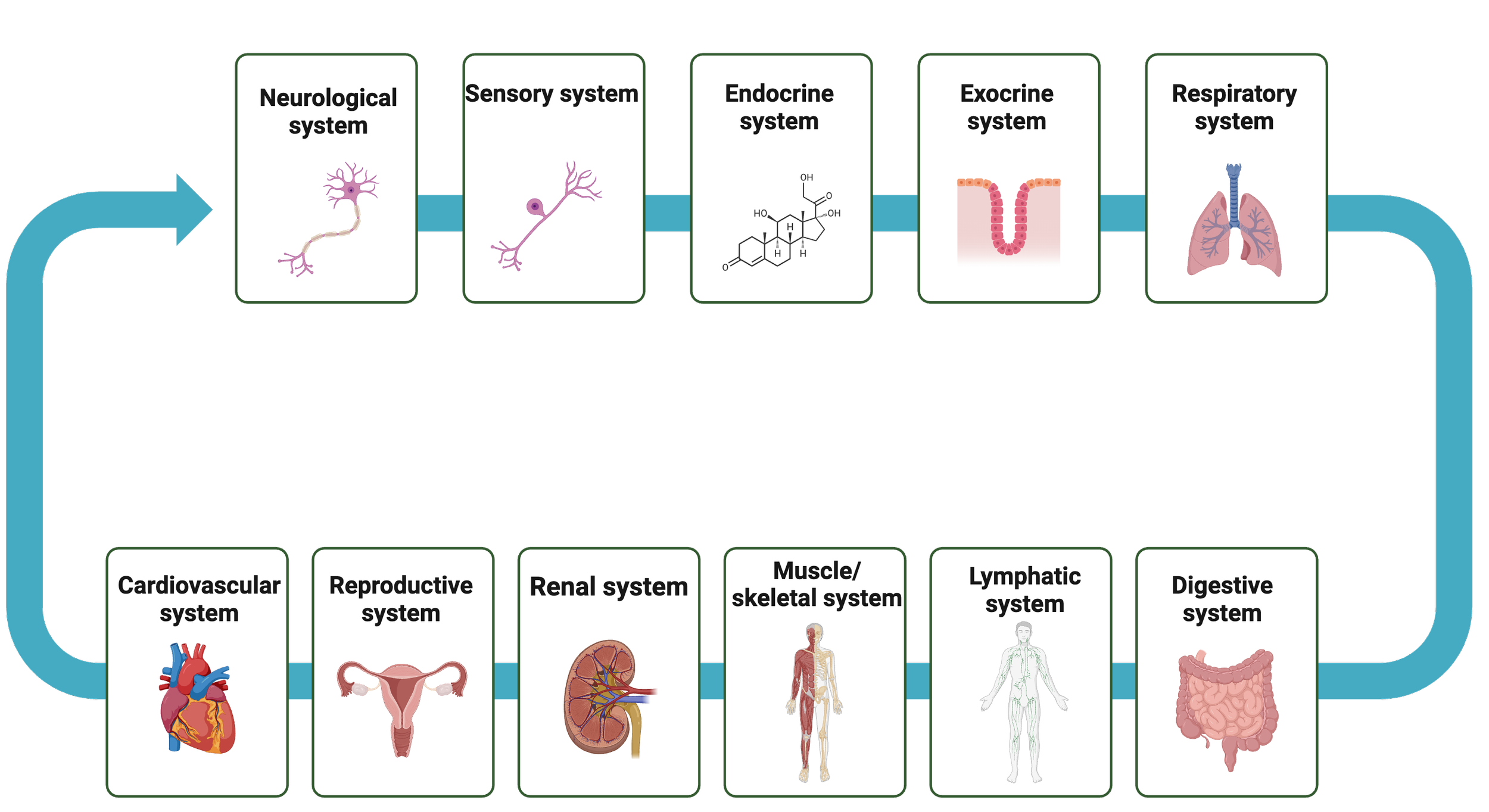Understanding the endocannabinoid system
The endocannabinoid system (ECS) is expressed throughout the body of every human being. Gain deeper knowledge about this underestimated system and its processes.
The regulatory systems of the human body
The endocannabinoid system (ECS) operates within all 11 physiological systems in the body, thereby regulating homeostasis.
Figure 1 - The physiological systems in the human body.
The ECS, which functions to achieve a state of equilibrium named homeostasis, is composed of endocannabinoids, enzymes, and receptors. Together, they act to respond to changes in our internal and external environment, thereby balancing our physiological functions.
The ECS is responsible for everything from developing the brain and the synapses within to modulating numerous body functions. It regulates our mood appetite, pain, and countless other integral aspects impacting our wellbeing (Scherma et al., 2019). As such, its proper functioning is vital for both our physical and mental health. But moreover, a sound understanding of the ECS is paramount to improving how we treat the conditions related to it.
The endocannabinoid system in a figure
The mechanism of action of the ECS. The ECS comprises:
endocannabinoids (eCBs),
receptors (CBRs), and
the enzymes responsible for the synthesis and degradation of eCBs.
Figure 2 - The elements involved and the process of mechanism of the endocannabinoid system
Legend
eCB, endocannabinoid; CB1R, cannabinoid 1 receptor; AEA, anandamide; FAAH, fatty acid amide hydrolase; 2-AG, 2-arachidonoylglycerol; MAGL, monoacylglycerol lipase. The + sign represents stimulation while the - sign defines the inhibition process.
The endocannabinoids (eCBs)
Endogenous cannabinoids (also called endocannabinoids or eCBs) are messenger molecules produced by the human body to transfer information via the ECS. In the brain such molecules are called neurotransmitters and are mainly protein-based. In contrast the eCBs are lipid-based messengers which bind to the cannabinoid receptors. Interestingly, endocannabinoids are so-called retrograde transmitters, which travel “backwards” across the chemical connection points between neurons, the synapses, to activate the cannabinoid receptors (Figure 2) (Lu & Mackie, 2021).
Their lipid nature results in some important differences to previously known protein-based neurotransmitters. In contrast to these classical neurotransmitters, which are synthesized ahead of time and stored in synaptic vesicles, endocannabinoids are produced when needed (on demand) from precursor molecules that are part of the cell’s lipid membrane. After synthesis, eCBs arereleased immediately (Lu & Mackie, 2016). They are key modulators of the communication between cells, namely neuronal signaling or synaptic transmission, i.e., neurotransmission (see also the section receptors).
Two major endocannabinoids have been identified to date:
Anandamide (N-arachidonoylethanolamine, AEA) and,
2-Arachidonoylglycerol (2-AG) (Devane et al., 1992; Sugiura et al., 1995; Mechoulam, 1995).
Figure 3 - The activity of the endocannabinoids (highlighted in color).
The two endocannabinoids have manifold functions in the brain and the periphery and control basic biological processes. However, due to their different affinity to cannabinoid and other receptors and their different synthesizing and metabolizing enzymes, they have distinct physiological roles (Lu & Mackie, 2021). Our current approaches focus on anandamide and enzyme inhibitors increasing anandamide levels in the body, thereby treating schizophrenia, and other mental health conditions.
Enzymes play an important role in cellular signaling.
Enzymes of the endocannabinoid system (ECS) function to synthesize and metabolize endocannabinoids once they are needed or have been used; in essence, they are key to the production and the recyclying of endocannabinoids (Figure 2).
There are several enzymes associated with the ECS. Each enzyme plays a different role:
synthesizing (e.g., NAPE-PLD, PLC, PLCβ PLA2, ABDH4, GDE1, PLA1, DAGL𝛂/β) or,
degrading (e.g., FAAH, MAGL, NAAA, ABHD6, ABHD12, COX-2) specific endocannabinoids (Lu & Mackie, 2016). The Fatty Acid Amide Hydrolase (FAAH), for example, is the primary enzyme responsible for metabolizing the endocannabinoid anandamide in the body.
Enzymes and carriers
It appears that proteins acting as carriers are needed to transport endocannabinoids in aqueous compartments in the cell and between cells or across membranes (Lu & Mackie, 2020). These seem to include, for example, fatty acid binding proteins (FABPs) (Elmes et al., 2015).
Figure 4 - The activity of the enzymes and its carriers involved in the process of the ECS.
Receptors
The role of receptors is to forward the signal of a messenger released on the other side of the space between neuronal connections, the synaptic cleft. Once activated by a specifically binding molecule, the receptor is generating a response on the other side of respective side of the synapsis. This is the basis for communication between neurons.
There are two well-studied receptors which are a part of the endocannabinoid system: the cannabinoid receptors CB1-R and CB2-R.
-
CB1-Rs are mainly found in the central nervous system, as well as in our connective tissue, gonads, and glands (ZU & Kumar, 2018). They are the most abundant G-protein receptor system in the body and e.g., contribute to the regulation of our sleep (Murillo-Rodriguez, 2008).
-
CB2-Rs are, e.g., most highly expressed on immune cells and its associated structures (Turcotte et al., 2016). They play a role, e.g., in modulating intestinal inflammation, contraction and pain in inflammatory bowel conditions (Wright et al, 2008). As a result, they pose significant potential in helping us modulate immune responses.
Endocannabinoids act as messengers (neurotransmitters) that bind to and activate the cannabinoid receptors. This activation, in turn, triggers various cellular responses. Cannabinoid receptors are localized on different kinds of neurons and on different parts of these neurons. Thereby, endocannabinoid signaling can influence a large number of neuronal activities and mediate several neurological and behavioral functions.
Figure 5 - The activity of the receptors involved in the process of the ECS.
Besides cannabinoid receptors, also other non-cannabinoid receptors mediate some endocannabinoid actions, particularly of anandamide.






